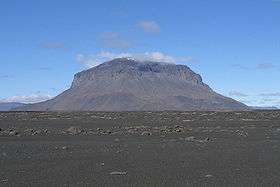Glaciovolcanism
Glaciovolcanism is volcanism and related phenomena associated with glacial ice. The ice commonly constrains the erupted material and melts to create meltwater. Considerable melting of glacial ice can create massive lahars and glacial outburst floods known as jökulhlaups.[1]
General
Three forms of glaciovolcanism are known. Subglacial eruptions occur when a volcano erupts under ice. Such activity can produce landforms such as tuyas and subglacial mounds. Ice-marginal volcanism takes place when material from a subaerial eruption makes lateral contact with ice. Ice-marginal lava flows are a product of this phenomenon. Supraglacial eruptions deposit ejecta onto the surface of an ice sheet.[2]
Examples
Isostatic rebound in response to glacier retreat (unloading), increase in local salinity (i.e., δ18Osw), have been attributed to increased volcanic activity at the onset of Bølling–Allerød, are associated with the interval of intense volcanic activity, hinting at a interaction between climate and volcanism - enhanced short-term melting of glaciers, possibly via albedo changes from particle fallout on glacier surfaces.[3]
See also
References
- ↑ Volcano-ice-water interaction
- ↑ Terminology commonly used to describe glaciovolcanic deposits
- ↑ Praetorius; et al. (2016). "Interaction between climate, volcanism, and isostatic rebound in Southeast Alaska during the last deglaciation". Earth and Planetary Science Letters. doi:10.1016/j.epsl.2016.07.033.
